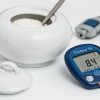- Two Types of Diabetes
- The Course of Kidney Disease
- Preventing and Slowing Kidney Disease
- Dialysis and Transplantation
- Good Care Makes a Difference
- Looking to the Future
- References
Each year in the United States, more than 50,000 people are diagnosed with end-stage renal disease (ESRD), a serious condition in which the kidneys fail to rid the body of wastes. ESRD is the final stage of a slow deterioration of the kidneys, a process known as nephropathy.
Primary Diagnoses (Causes) for ESRD (1991)
- 35.9 percent Diabetes
- 28.8 percent High Blood Pressure
- 18.1 percent Other Causes
- 11.4 percent Glomerulonephritis
- 2.9 percent Polycystic Kidney Disease
- 2.9 percent Interstitial Nephritis
Diabetes is the most common cause of ESRD, resulting in about one-third of new ESRD cases. Even when drugs and diet are able to control diabetes, the disease can lead to nephropathy and ESRD. Most people with diabetes do not develop nephropathy that is severe enough to cause ESRD. About 15 million people in the United States have diabetes, and about 50,000 people have ESRD as a result of diabetes.
ESRD patients undergo either dialysis, which substitutes for some of the filtering functions of the kidneys, or transplantation to receive a healthy donor kidney. Most U.S. citizens who develop ESRD are eligible for federally funded care. In 1994, the Federal Government spent about $9.3 billion on care for patients with ESRD.
African Americans and Native Americans develop diabetes, nephropathy, and ESRD at rates higher than average. Scientists have not been able to explain these higher rates. Nor can they explain fully the interplay of factors leading to diabetic nephropathy--factors including heredity, diet, and other medical conditions, such as high blood pressure. They have found that high blood pressure and high levels of blood sugar increase the risk that a person with diabetes will progress to ESRD.
In diabetes--also called diabetes mellitus, or DM--the body does not properly process and use certain foods, especially carbohydrates. The human body normally converts carbohydrates to glucose, the simple sugar that is the main source of energy for the body's cells. To enter cells, glucose needs the help of insulin, a hormone produced by the pancreas. When a person does not make enough insulin, or the body is unable to use the insulin that is present, the body cannot process glucose, and it builds up in the bloodstream. High levels of glucose in the blood or urine lead to a diagnosis of diabetes.
NIDDM
Most people with diabetes have a form known as noninsulin-dependent diabetes (NIDDM), or Type II diabetes. Many people with NIDDM do not respond normally to their own or to injected insulin--a condition called insulin resistance. NIDDM occurs more often in people over the age of 40, and many people with NIDDM are overweight. Many also are not aware that they have the disease. Some people with NIDDM control their blood sugar with diet and an exercise program leading to weight loss. Others must take pills that stimulate production of insulin; still others require injections of insulin.
IDDM
A less common form of diabetes, known as insulin-dependent diabetes (IDDM), or Type I diabetes, tends to occur in young adults and children. In cases of IDDM, the body produces little or no insulin. People with IDDM must receive daily insulin injections.
NIDDM accounts for about 95 percent of all cases of diabetes; IDDM accounts for about 5 percent. Both types of diabetes can lead to kidney disease. IDDM is more likely to lead to ESRD. About 40 percent of people with IDDM develop severe kidney disease and ESRD by the age of 50. Some develop ESRD before the age of 30. NIDDM causes 80 percent of the ESRD in African Americans and Native Americans.
The deterioration that characterizes kidney disease of diabetes takes place in and around the glomeruli, the blood-filtering units of the kidneys. Early in the disease, the filtering efficiency diminishes, and important proteins in the blood are lost to the urine. Medical professionals gauge the presence and extent of early kidney disease by measuring protein in the urine. Later in the disease, the kidneys lose their ability to remove waste products, such as creatinine and urea, from the blood.
Symptoms related to kidney failure usually occur only in late stages of the disease, when kidney function has diminished to less than 25 percent of normal capacity. For many years before that point, kidney disease of diabetes exists as a silent process.
Five Stages
Scientists have described five stages in the progression to ESRD in people with diabetes. They are as follows:
Stage I. The flow of blood through the kidneys, and therefore through the glomeruli, increases--this is called hyperfiltration--and the kidneys are larger than normal. Some people remain in stage I indefinitely; others advance to stage II after many years.
Stage II. The rate of filtration remains elevated or at near-normal levels, and the glomeruli begin to show damage. Small amounts of a blood protein known as albumin leak into the urine--a condition known as microalbuminuria. In its earliest stages, microalbuminuria may come and go. But as the rate of albumin loss increases from 20 to 200 micrograms per minute, microalbuminuria becomes more constant. (Normal losses of albumin are less than 5 micrograms per minute.) A special test is required to detect microalbuminuria. People with NIDDM and IDDM may remain in stage II for many years, especially if they have normal blood pressure and good control of their blood sugar levels.
Stage III. The loss of albumin and other proteins in the urine exceeds 200 micrograms per minute. It now can be detected during routine urine tests. Because such tests often involve dipping indicator strips into the urine, they are referred to as "dipstick methods." Stage III sometimes is referred to as "dipstick-positive proteinuria" (or "clinical albuminuria" or "overt diabetic nephropathy"). Some patients develop high blood pressure. The glomeruli suffer increased damage. The kidneys progressively lose the ability to filter waste, and blood levels of creatinine and urea-nitrogen rise. People with IDDM and NIDDM may remain at stage III for many years.
Stage IV. This is referred to as "advanced clinical nephropathy." The glomerular filtration rate decreases to less than 75 milliliters per minute, large amounts of protein pass into the urine, and high blood pressure almost always occurs. Levels of creatinine and urea-nitrogen in the blood rise further.
Stage V. The final stage is ESRD. The glomerular filtration rate drops to less than 10 milliliters per minute. Symptoms of kidney failure occur.
These stages describe the progression of kidney disease for most people with IDDM who develop ESRD. For people with IDDM, the average length of time required to progress from onset of kidney disease to stage IV is 17 years. The average length of time to progress to ESRD is 23 years. Progression to ESRD may occur more rapidly (5-10 years) in people with untreated high blood pressure. If proteinuria does not develop within 25 years, the risk of developing advanced kidney disease begins to decrease. Advancement to stages IV and V occurs less frequently in people with NIDDM than in people with IDDM. Nevertheless, about 60 percent of people with diabetes who develop ESRD have NIDDM.
Effects of High Blood Pressure
High blood pressure, or hypertension, is a major factor in the development of kidney problems in people with diabetes. Both a family history of hypertension and the presence of hypertension appear to increase chances of developing kidney disease. Hypertension also accelerates the progress of kidney disease where it already exists.
Hypertension usually is defined as blood pressure exceeding 140 millimeters of mercury-systolic and 90 millimeters of mercury-diastolic. Professionals shorten the name of this limit to "140 over 90." The terms systolic and diastolic refer to pressure in the arteries during contraction of the heart (systolic) and between heartbeats (diastolic).
Hypertension can be seen not only as a cause of kidney disease, but also as a result of damage created by the disease. As kidney disease proceeds, physical changes in the kidneys lead to increased blood pressure. Therefore, a dangerous spiral, involving rising blood pressure and factors that raise blood pressure, occurs. Early detection and treatment of even mild hypertension are essential for people with diabetes.
Preventing and Slowing Kidney Disease
Blood Pressure Medicines
Scientists have made great progress in developing methods that slow the onset and progression of kidney disease in people with diabetes. Drugs used to lower blood pressure (antihypertensive drugs) can slow the progression of kidney disease significantly. One drug, an angiotensin-converting enzyme (ACE) inhibitor, has proven effective in preventing progression to stages IV and V.1 Calcium channel blockers, another class of antihypertensive drugs, also show promise
.An example of an effective ACE inhibitor is captopril, which the Food and Drug Administration approved for treating kidney disease of Type I diabetes. The benefits of captopril extend beyond its ability to lower blood pressure; it may directly protect the kidney's glomeruli. ACE inhibitors have lowered proteinuria and slowed deterioration even in diabetic patients who did not have high blood pressure.
Some, but not all, calcium channel blockers may be able to decrease proteinuria and damage to kidney tissue. Researchers are investigating whether combinations of calcium channel blockers and ACE inhibitors might be more effective than either treatment used alone. Patients with even mild hypertension or persistent microalbuminuria should consult a physician about the use of antihypertensive medicines.
Low-Protein Diets
A diet containing reduced amounts of protein may benefit people with kidney disease of diabetes. In people with diabetes, excessive consumption of protein may be harmful. Experts recommend that most patients with stage III or stage IV nephropathy consume moderate amounts of protein.
Intensive Management
Antihypertensive drugs and low-protein diets can slow kidney disease when significant nephropathy is present, as in stages III and IV. A third treatment, known as intensive management or glycemic control, has shown great promise for people with IDDM, especially for those with early stages of nephropathy.
Intensive management is a treatment regimen that aims to keep blood glucose levels close to normal. The regimen includes frequently testing blood sugar, administering insulin on the basis of food intake and exercise, following a diet and exercise plan, and frequently consulting a health care team.
A number of studies have pointed to the beneficial effects of intensive management. Two such studies, funded by the National Institute of Diabetes and Digestive and Kidney Diseases (NIDDK) of the National Institutes of Health, are the Diabetes Control and Complications Trial (DCCT)2 and a trial led by researchers at the University of Minnesota Medical School.3
The DCCT, conducted from 1983 to 1993, involved 1,441 participants who had IDDM. Researchers found a 50-percent decrease in both development and progression of early diabetic kidney disease (stages I and II) in participants who followed an intensive regimen for controlling blood sugar levels. The intensively managed patients had average blood sugar levels of 150 milligrams per deciliter--about 80 milligrams per deciliter lower than the levels observed in the conventionally managed patients.
In the Minnesota Medical School trial, researchers examined kidney tissues of long-term diabetics who received healthy kidney transplants. After 5 years, patients who followed an intensive regimen developed significantly fewer lesions in their glomeruli than did patients not following an intensive regimen. This result, along with findings of the DCCT and studies performed in Scandinavia, suggests that any program resulting in sustained lowering of blood glucose levels will be beneficial to patients in the early stages of diabetic nephropathy.
When people with diabetes reach ESRD, they must undergo either dialysis or a kidney transplant. As recently as the 1970's, medical experts commonly excluded people with diabetes from dialysis and transplantation, in part because the experts felt damage caused by diabetes would offset benefits of the treatments. Today, because of better control of diabetes and improved rates of survival following treatment, doctors do not hesitate to offer dialysis and kidney transplantation to people with diabetes.
Currently, the survival of kidneys transplanted into diabetes patients is about the same as survival of transplants in people without diabetes. Dialysis for people with diabetes also works well in the short run. Even so, people with diabetes who receive transplants or dialysis experience higher morbidity and mortality because of coexisting complications of the diabetes--such as damage to the heart, eyes, and nerves.
If you have diabetes:
- Ask your doctor about the DCCT and how its results might help you.
- Have your doctor measure your glycohemoglobin regularly. The HbA1c test averages your level of blood sugar for the previous 1-3 months.
- Follow your doctor's advice regarding insulin injections, medicines, diet, exercise, and monitoring your blood sugar.
- Have your blood pressure checked several times a year. If blood pressure is high, follow your doctor's plan for keeping it near normal levels.
- Ask your doctor whether you might benefit from receiving an ACE inhibitor.
- Have your urine checked yearly for microalbumin and protein. If there is protein in your urine, have your blood checked for elevated amounts of waste products such as creatinine.
- Ask your doctor whether you should reduce the amount of protein in your diet.
The incidences of both diabetes and ESRD caused by diabetes have been rising. Some experts predict that diabetes soon might account for half the cases of ESRD. In light of the increasing morbidity and mortality related to diabetes and ESRD, patients, researchers, and health care professionals will continue to benefit by addressing the relationship between the two diseases. The NIDDK is a leader in supporting research in this area.
Several areas of research supported by NIDDK hold great potential. Discovery of ways to predict who will develop kidney disease may lead to greater prevention, as people with diabetes who learn they are at risk institute strategies such as intensive management and blood pressure control. Discovery of better anti-rejection drugs will improve results of kidney transplantation in patients with diabetes who develop ESRD. For some people with IDDM, advances in transplantation--especially transplantation of insulin-producing cells of the pancreas--could lead to a cure for both diabetes and the kidney disease of diabetes.
1. Lewis, E.J., et al., The effect of angiotensin-converting-enzyme inhibition on diabetic nephropathy. New England Journal of Medicine, Vol. 329, No. 20, pp. 1456-1462, 1993.
2. Diabetes Control and Complications Trial [fact sheet], August 1994. National Diabetes Information Clearinghouse, 1 Information Way, Bethesda, MD 20892-3560.
3. Barbosa, J., et al., Effect of glycemic control on early diabetic renal lesions. Journal of the American Medical Association, Vol. 272, No. 8, pp. 600-606, 1994.
NIDDK










